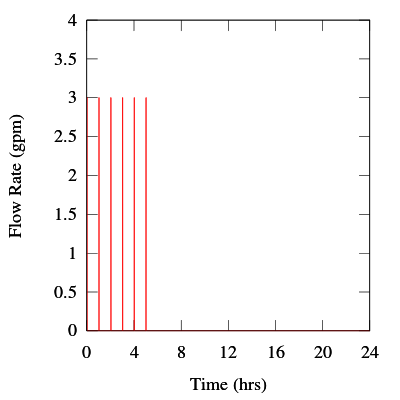Energy factor
An energy factor is a metric used in the United States to compare the energy conversion efficiency of residential appliances and equipment. The energy factor is currently used for rating the efficiency of water heaters, dishwashers, clothes washers, and clothes dryers.[1] The term is used by the United States Department of Energy to develop and enforce minimum energy conservation standards under the Energy Conservation Program.[2]
The higher the energy factor, the more efficient the appliance should be.[3]
Although the term energy factor is used to compare the relative efficiency of these appliances, the metric is defined differently for all four appliance categories. The energy factor is expressed in terms of site energy, which excludes losses through energy conversion. All of these efficiency metrics are defined by Department of Energy test procedures.[4]
Water heaters
The energy factor metric only applies to residential water heaters, which are currently defined by fuel, type, and input capacity.[5]
| Fuel | Type | Input capacity |
|---|---|---|
| Natural Gas | Storage | ≤75 kBtu/h |
| Fuel Oil | Storage | ≤105 kBtu/h |
| Electric | Storage | ≤12 kW |
| Tabletop | Storage | ≤12 kW |
| Natural Gas | Instantaneous | <200 kBtu/hr |
| Electric | Instantaneous | ≤12 kW |
Test procedure

The energy factor for residential water heaters is determined using the results from the 24-hour simulated use test. During the test 64.3±1.0 gallons of water are drawn from the water heater in six equally spaced draws that begin one hour apart. The hot water flow rate for each draw is 3.0±0.25 gallons per minute. After the beginning of the last draw a standby period of 18 hours follows. During the test, the test conditions must be operated at a specified value and accuracy. Heat pump water heaters (HPWHs) have different values specified for ambient air temperature and relative humidity.[6]
| Measurement | Required value and accuracy |
|---|---|
| Inlet water temperature | 58 °F±2 °F |
| Outlet water temperature | 135 °F±5 °F |
| Ambient air temperature | 67.5 °F±2.5 °F |
| Ambient air temperature (HPWHs only) | 67.5 °F±1 °F |
| Ambient relative humidity (HPWHs only) | 50%±1% |
From the standard test procedure, the energy factor is defined as
where is the modified daily water heating energy consumption (Btu), is the mass withdrawn from the ith draw (lb), and is the specific heat of the water of the ith draw Btu/lb°F.
Energy conservation standards
Minimum federal energy conservation standards are defined by fuel, type, and rated storage volume. All standards are calculated as a function of the rated storage volume V in gallons. The current conservation standards are less efficient than the standards that go into effect in 2015.[5][7][8]
| Fuel | Type | Rated Storage Volume | Energy Factor (Effective April 16, 2015) | Energy Factor |
|---|---|---|---|---|
| Natural Gas | Storage | ≥ 20 gal and ≤ 55 gal | 0.675 − 0.0015V | 0.67 − 0.0019V |
| Natural Gas | Storage | > 55 gal and ≤ 100 gal | 0.8012 − 0.00078V | 0.67 − 0.0019V |
| Fuel Oil | Storage | ≤ 50 gal | 0.68 − 0.0019V | 0.59 − 0.0019V |
| Electric | Storage | ≥ 20 gal and ≤ 55 gal | 0.960 − 0.0003V | 0.97 − 0.00132V |
| Electric | Storage | > 55 gal and ≤ 120 gal | 2.057 − 0.00113V | 0.97 − 0.00132V |
| Tabletop | Storage | ≥ 20 gal and ≤ 100 gal | 0.93 − 0.00132V | 0.93 − 0.00132V |
| Natural Gas | Instantaneous | < 2 gal | 0.82 − 0.0019V | 0.62 − 0.0019V |
| Electric | Instantaneous | < 2 gal | 0.93 − 0.00132V | 0.93 − 0.00132V |
Dishwashers
The energy factor for dishwashers is defined as "the number of cycles per kWh of input power."[1]
Clothes washers
The energy factor for clothes washers, is defined as "the cubic foot capacity per kWh of input power per cycle."[1]
Clothes dryers
The energy factor for clothes dryers is defined as "the number of pounds of clothes dried per kWh of power consumed."[1]
See also
- Energy star
References
- "Federal Tax Credits for Consumer Energy Efficiency: Definitions". energystar.gov. U.S. Environmental Protection Agency. Archived from the original on 1 April 2013. Retrieved 26 March 2013.
- "ESTIMATING COSTS AND EFFICIENCY OF STORAGE, DEMAND, AND HEAT PUMP WATER HEATERS". Energy.gov. US Dept of Energy. Retrieved 2 June 2016.
- "Standards and Test Procedures". eere.energy.gov. U.S. Department of Energy. Retrieved 26 March 2013.
- "Residential Water Heaters". eere.energy.gov. U.S. Department of Energy. Retrieved 26 March 2013.
- "10 CFR Part 430 Energy Conservation Program for Consumer Products: Test Procedure for Water Heaters; Final Rule" (PDF). Federal Register. 63 (90): 25995–26016. 11 May 1998. Retrieved 26 March 2013.
- "10 CFR Part 430 Energy Conservation Program: Energy Conservation Standards for Residential Water Heaters, Direct Heating Equipment, and Pool Heaters; Final Rule" (PDF). Federal Register. 75 (73): 20112-21981 [20113]. 16 April 2010. Retrieved 26 March 2013.
- "10 CFR Part 430 Energy Conservation Program for Consumer Products: Energy Conservation Program for Consumer Products: Energy Conservation Standards for Water Heaters; Final Rule" (PDF). Federal Register. 66 (11): 4474–4497 [4497]. 17 January 2001. Retrieved 26 March 2013.